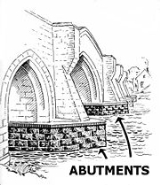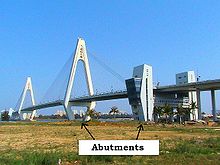
Abutment
Encyclopedia
.jpg)

Specifically, an abutment may be:
- the part of a structure that supports an archArchAn arch is a structure that spans a space and supports a load. Arches appeared as early as the 2nd millennium BC in Mesopotamian brick architecture and their systematic use started with the Ancient Romans who were the first to apply the technique to a wide range of structures.-Technical aspects:The...
. - the tooth or teeth that support a fixed or removable bridgeBridge (dentistry)A bridge, also known as a fixed partial denture, is a dental restoration used to replace a missing tooth by joining permanently to adjacent teeth or dental implants....
. - the part of an implant that acts as a connection between the implantDental implantA dental implant is a "root" device, usually made of titanium, used in dentistry to support restorations that resemble a tooth or group of teeth to replace missing teeth....
and the crownCrown (dentistry)A crown is a type of dental restoration which completely caps or encircles a tooth or dental implant. Crowns are often needed when a large cavity threatens the ongoing health of a tooth. They are typically bonded to the tooth using a dental cement. Crowns can be made from many materials, which...
.
Architecture
In architecture an abutment is formed of "solid masonry placed to resist the lateral pressure of a vault" (Nikolaus Pevsner).Civil engineering
An abutment supports the ends of a bridgeBridge
A bridge is a structure built to span physical obstacles such as a body of water, valley, or road, for the purpose of providing passage over the obstacle...
superstructure
Superstructure
A superstructure is an upward extension of an existing structure above a baseline. This term is applied to various kinds of physical structures such as buildings, bridges, or ships...
. The intermediate supports in a multi-span bridge are known as piers.
Abutments are used for the following purposes:
- to transmit the loads from the superstructure to the foundationsFoundation (architecture)A foundation is the lowest and supporting layer of a structure. Foundations are generally divided into two categories: shallow foundations and deep foundations.-Shallow foundations:...
. Resist and transmit the following loads to the foundations: loads from the superstructure, own weight, and lateral loads such as the earth pressure, surcharge live loads, and wind loads. - to support the end of the first or the last span.
- to retain the earth underneath and adjacent to the approach roadway, and if necessary support part of the approach slab.
There are different types of abutments including:
Gravity Abutment
- resists horizontal earth pressure with its own dead weight
U Abutment
- U shaped gravity abutment
Cantilever Abutment
- Cantilever retaining wall designed for large vertical loads
Full Height Abutment
- Cantilever abutment that extends from the underpass grade line to the grade line of the overpass roadway
Stub Abutment
- Short abutments at the top of an embankment or slope. Usually supported on piles.
Semi-Stub Abutment
- Size between full height and stub abutment
Counterfort Abutment
- Similar to counterfort retaining walls
Spill-through Abutment
- Vertical buttresses with open spaces between them
MSE systems
- “Reinforced earth” system: modular units with metal or polymeric reinforcement
Pile Bent abutment
- Similar to Spill-through Abutment
Abutment is also a term used by civil engineer
Civil engineer
A civil engineer is a person who practices civil engineering; the application of planning, designing, constructing, maintaining, and operating infrastructures while protecting the public and environmental health, as well as improving existing infrastructures that have been neglected.Originally, a...
s in dam
Dam
A dam is a barrier that impounds water or underground streams. Dams generally serve the primary purpose of retaining water, while other structures such as floodgates or levees are used to manage or prevent water flow into specific land regions. Hydropower and pumped-storage hydroelectricity are...
construction
Construction
In the fields of architecture and civil engineering, construction is a process that consists of the building or assembling of infrastructure. Far from being a single activity, large scale construction is a feat of human multitasking...
; moving water from a large reservoir to a channel such as a spillway
Spillway
A spillway is a structure used to provide the controlled release of flows from a dam or levee into a downstream area, typically being the river that was dammed. In the UK they may be known as overflow channels. Spillways release floods so that the water does not overtop and damage or even destroy...
, there are smooth transition walls at both sides named abutments which minimize the water's energy loss.

